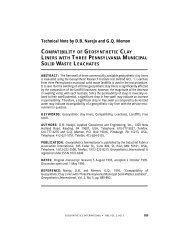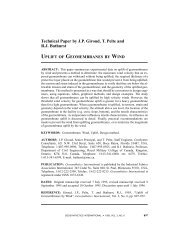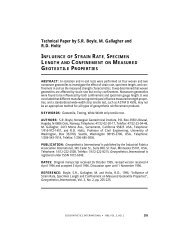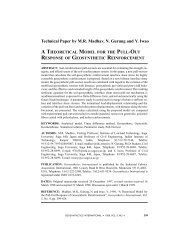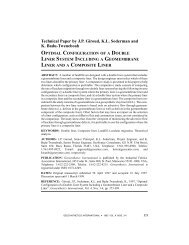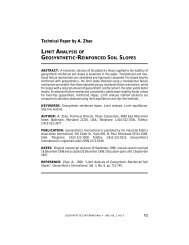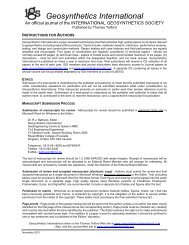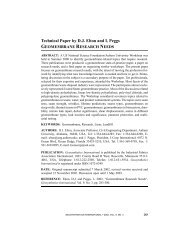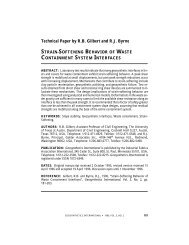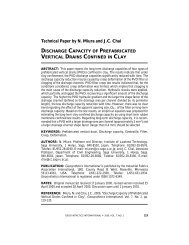leachate flow in leakage collection layers due to defects in ...
leachate flow in leakage collection layers due to defects in ...
leachate flow in leakage collection layers due to defects in ...
Create successful ePaper yourself
Turn your PDF publications into a flip-book with our unique Google optimized e-Paper software.
GIROUD et al. D Leachate Flow <strong>in</strong> Leakage Collection Layers Due <strong>to</strong> Geomembrane Defects<br />
approximately the same <strong>in</strong> all directions. S<strong>in</strong>ce the hydraulic gradient is closely related<br />
<strong>to</strong> the slope of the phreatic surface, it may then be assumed that the slope of the cone<br />
generatrices is the same <strong>in</strong> all directions. The slope of the phreatic surface (i.e. the slope<br />
of the cone generatrix) <strong>in</strong> the direction of the slope of the <strong>leakage</strong> <strong>collection</strong> layer is<br />
approximately known: it is close <strong>to</strong> the slope angle, β, s<strong>in</strong>ce the <strong>flow</strong> thickness is small<br />
compared <strong>to</strong> the length of the <strong>leakage</strong> <strong>collection</strong> layer. Therefore, it is assumed that the<br />
angle between all generatrices of the cone that form the phreatic surface of <strong>leachate</strong> and<br />
a horizontal plane is β (Figure 4).<br />
From the forego<strong>in</strong>g discussion, it appears that the wetted zone (Figure 1b) is parabolic<br />
s<strong>in</strong>ce the <strong>in</strong>tersection of a cone and a plane parallel <strong>to</strong> a generatrix of the cone is a parabola.<br />
However, the actual wetted zone is only approximately parabolic because several<br />
simplify<strong>in</strong>g assumptions were made, as <strong>in</strong>dicated <strong>in</strong> Section 2.1 and, above, <strong>in</strong> Section<br />
2.2.<br />
2.3 Assumptions Specific <strong>to</strong> the Case Where the Leakage Collection Layer is<br />
Full<br />
The case where “the <strong>leakage</strong> <strong>collection</strong> layer is full” is the case where the <strong>flow</strong> rate<br />
through the considered defect <strong>in</strong> the primary l<strong>in</strong>er is large enough that the thickness of<br />
<strong>leachate</strong> <strong>in</strong> the <strong>leakage</strong> <strong>collection</strong> layer is equal <strong>to</strong> the thickness of the <strong>leakage</strong> <strong>collection</strong><br />
layer <strong>in</strong> an area greater than zero around the defect <strong>in</strong> the primary l<strong>in</strong>er. At the periphery<br />
of this area, the <strong>leachate</strong> phreatic surface is <strong>in</strong> contact with the primary l<strong>in</strong>er.<br />
As <strong>in</strong>dicated <strong>in</strong> Section 2.2, the case where the <strong>leakage</strong> <strong>collection</strong> layer is not full is<br />
the lead case. Accord<strong>in</strong>gly, assumptions regard<strong>in</strong>g the hydraulic gradient and the shape<br />
of the phreatic surface (described <strong>in</strong> Section 2.2 for the case where the <strong>leakage</strong> <strong>collection</strong><br />
layer is not full) will be adapted <strong>to</strong> the case where the <strong>leakage</strong> <strong>collection</strong> layer is<br />
full, as shown <strong>in</strong> Section 3.2.<br />
3 RATEOFLEACHATEFLOW<br />
3.1 Rate of Leachate Flow When the Leakage Collection Layer is not Full<br />
The <strong>leakage</strong> <strong>collection</strong> layer is not full if the follow<strong>in</strong>g condition is met:<br />
t<br />
o<br />
£ t<br />
LCL<br />
(1)<br />
where: t o = maximum thickness of <strong>leachate</strong> <strong>in</strong> the <strong>leakage</strong> <strong>collection</strong> layer, which occurs<br />
at the defect of the primary l<strong>in</strong>er, i.e. at the apex of the phreatic surface (Figure 4a); and<br />
t LCL = thickness of the <strong>leakage</strong> <strong>collection</strong> layer (Figures 3 and 4a).<br />
In the case where the <strong>leakage</strong> <strong>collection</strong> layer is not full, the vertical cross section of<br />
the <strong>flow</strong> <strong>in</strong> a plane pass<strong>in</strong>g through the defect and conta<strong>in</strong><strong>in</strong>g the horizontal con<strong>to</strong>ur<br />
l<strong>in</strong>es of the l<strong>in</strong>ers (Figure 4b) is a triangle whose surface area is:<br />
S= 2 /tanb<br />
D o<br />
(2)<br />
222 GEOSYNTHETICS INTERNATIONAL S 1997, VOL. 4, NOS. 3-4



